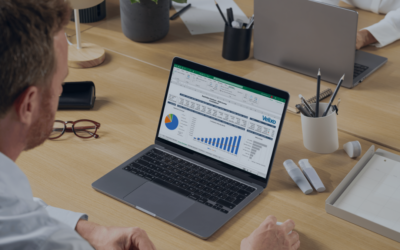Enterprise resource planning (ERP) systems describe business management software that gives your organization the resources necessary to automate, integrate, and streamline its core processes. ERP systems simplify day-to-day operations involving human resources, finance, supply chain, inventory, and other management functions while offering a single source for an organization’s data. However, various challenges can arise during the implementation process, ranging from issues with data migration to data security concerns and integration obstacles. This article will help you by giving the best tips for ERP implementation success to guarantee that you can implement, integrate, and benefit from your ERP solution.
Our Expert Tips for ERP Implementation success
1. Pre-Implementation Planning
The first step to any successful ERP implementation is planning early. Let’s explore the steps you need to take to accomplish this goal.
Define Clear Objectives
Understand exactly what you need from the ERP implementation process and have specific goals to align with your organization’s strategic vision. Consider the following questions: do you need an ERP solution for improved supply chain management? Is your ERP system aimed at enhancing customer relationship management (CRM) processes? Do you need a scalable system?
Create a Cross-Functional Team
As a holistic solution, ERP requires input from various employees. A cross-functional team will help you identify your needs and frustrations while providing essential support during implementation.
Your project manager should create a team of various staff members from different departments for a well-rounded approach to implementation informed by unique perspectives.
Conduct a Thorough Needs Assessment
Ensuring implementation success is impossible if you don’t know what issues your ERP system is solving. The planning stage of ERP implementation is the perfect time to determine exactly where an ERP solution will step in to solve your frustrations. Analyze your current organizational processes, workflows, and challenges to fully understand your requirements.
2. Vendor Selection
Choosing the right ERP vendor is one of the best tips for a successful enterprise resource planning project because it can significantly increase your chances of optimizing your return on investment (ROI). When choosing a vendor, remember:
- Always research potential ERP vendors: Explore different ERP solutions to guarantee that your vendor aligns with your organization’s needs and budget.
- Evaluate the vendor’s reputation and support services: Always check references, case studies, and customer reviews to determine the vendor’s reliability and customer service.
- Request and compare vendor proposals: Get detailed proposals from all of your shortlisted vendors to assess the best fit for your organization.
3. Customization and Configuration
A customizable ERP solution is vital to the implementation process. Remember the following as you navigate customization and configuration:
Avoid Excessive Customization
Personalizing your system is always an advantage, but some teams take customization too far, making their ERP system less effective. Choose configurations that align with your organization’s existing processes to minimize complexities and guarantee smooth adoption.
Focus on Essential Features
By knowing your organization’s exact needs, your implemented ERP solutions will focus on the essentials. As you navigate implementation, prioritize the features and functionalities directly correlating with your organization’s requirements. For instance, if you need a supply chain or financial management solutions, focus on solutions and features that address these issues.
Ensure Scalability
ERP systems foster change and growth in an organization, meaning you need a scalable and customizable system to suit your company’s growth. Ensure that your solution can adapt to future changes in the business landscape.
4. Data Migration and Cleansing
The migration and cleansing process is crucial to a successful team ERP implementation project. Ensure that the following are complete for a seamless implementation.
Plan Data Migration Carefully
Ensure an efficient transfer of information from legacy systems to your new ERP system by having a comprehensive data migration strategy and understanding your migration and ERP projects.
Cleanse and Validate Data
Data must be consistent and accurate before you can transfer it to your new ERP system. So, before you migrate it, clean and organize the data.
Perform Test Migrations
One crucial tip for a successful ERP implementation is to execute a pilot migration, using a smaller subset of data to determine any bottlenecks before full-scale migration. Perform as many test migrations as necessary to eliminate issues before implementing.
5. Training and Change Management
The only way to ensure successful user adoption is to provide employees with the training necessary to master ERP solutions. Solutions that provide ongoing training services ensure the long-term success of your implementation strategy.
Invest in Comprehensive Training
Provide training to all employees using the ERP system to ensure proper utilization. Employees won’t be able to use the ERP system to enhance business processes without a clear understanding of how it works.
Facilitate Change Management
To ensure that employees readily adapt to change, you need to communicate the benefits of the ERP system to your workforce and address any concerns they have about the operational shift.
Foster a Culture of Adaptability
Encourage your employees to embrace organizational changes and actively take part in implementation success to eliminate the fear of change.
6. Pilot Testing and Feedback
Testing your ERP system before full-scale implementation ensures your solution meets its goals. Always include the following processes in your ERP implementation phases:
- Conduct pilot tests: Implement your ERP system in a controlled environment where you can identify and rectify potential issues before full-scale implementation.
- Gather feedback from users: Constantly seek feedback from end-users to address any usability concerns with your ERP system and enhance the user experience.
- Iteratively refine the implementation: Continuously improve the ERP system based on collected feedback and lessons learned during pilot testing.
7. Go-Live and Support
Providing consistent support during and following the go-live phase is crucial. This implementation phase includes the following processes:
Schedule a Well-Planned Go Live
First, you must set a date for your ERP system’s full deployment. Determine a date that will cause minimal disruption to daily business operations to avoid organizational issues.
Establish a Support System
Having ERP support is vital to a consistently successful system. Have dedicated support during and following the go-live phase to address implementation and ongoing issues as they arise.
Monitor Performance and Progress
Consistent monitoring and frequent assessments are crucial to implementation success and a sustainable ERP system. Conduct assessments to understand your system’s performance and its impact on organizational processes.
8. Continuous Optimization
Keeping your ERP system up-to-date and fostering a culture of continuous improvement is crucial to ensure that your solution is scalable and effective. You can encourage continuous optimization in the following ways:
- Promote ongoing training: Always encourage continuous learning to maximize the ERP system’s potential and encourage employees to reach their full potential.
- Monitor key performance indicators (KPIs): Track crucial KPIs to assess your ERP system’s effectiveness in achieving organizational objectives.
- Adapt to shifting needs: Always be prepared to change your ERP system as your organization grows and business requirements change.
Conclusion
The most important tips for ERP implementation success are:
- Remember pre-implementation planning.
- Carefully select your vendor.
- Prioritize customization and configuration.
- Navigate data migration and cleansing.
- Encourage training and change management.
- Conduct pilot testing and get feedback.
- Schedule a go-live and offer support.
- Foster continuous optimization.
You can streamline your business processes and unlock your full organizational potential by implementing an ERP system. Readers can get more tips for ERP implementation success by downloading our eBook on the best ERP implementation approaches.



